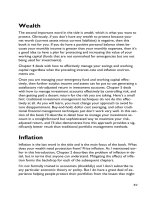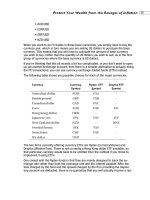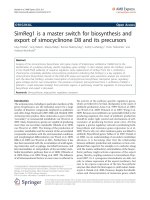everyone is a customer a proven method for measuring the value of every relationship in the era of collaborati phần 10 ppt
Bạn đang xem bản rút gọn của tài liệu. Xem và tải ngay bản đầy đủ của tài liệu tại đây (249.93 KB, 20 trang )
192 Part Three
❘
Choreographing Your Success
'
FIGURE 10.1
❘
Purposeful Collaboration Process
1. Set Goals (Figure 6.4)—Start by identifying your goals
for the current period. Once you’ve written out your
goals and identified the milestone, you’ll use to assess
performance, determine the relative importance of each
goal and assign a weighting factor.
2. Currencies Needed (Figure 6.5)—Having determined
your goals, identify the specific currencies you believe
are necessary to help you achieve each of your goals.
3. Four Questions (Figure 6.6)—Now that you’ve identi-
fied your goals and the currencies you need, go through
all of your relationships, answering the four questions
about every individual.
4. Select Scenarios (Figure 6.2)—By answering the four
questions, you can place every relationship into one of
nine different relationship scenario categories. Then
identify the specific Relationship Scenarios you want to
dig deeper into. Remember, Scenarios A–D represent the
greatest opportunity.
5. Rate Value (Figure 7.1)—In preparation for completing a
Relationship Scorecard for each person in the identified
scenarios, assess the level and utility of the currencies
you believe you’ll receive from each person.
6. Relationship Scorecard (Figure 7.2)—Using the cur-
rency value 5-point rating system, complete a current
and future Relationship Scorecard for each person you
evaluate.
7. Prioritize Relationships (Figure 7.8)—Now it’s time to
establish priorities. Calculating the Relationship Value
Delta (Future Relationship Value − Current Relationship
Value) determines the relative priority of all your rela-
tionships. The scorecard provides a wealth of informa-
tion, so analyze that too.
10
❘
How Yo u Do Business in the Era of Collaborative Business 193
8. Collaborate (Figure 8.1)—Now that you’ve determined
with whom you want to collaborate and the specific cur-
rencies each could provide, you must build the required
level of trust through the activities associated with each
level of collaboration. You do this by constructing a se-
ries of value propositions that get each party succes-
sively closer to obtaining the currencies it needs to
achieve its goals.
9. Evaluate Performance (Figure 9.5)—After every interac-
tion, assess whether you’ve gained access to the desired
currencies. Then, based on your analysis and your abil-
ity to see the pattern in the data, refine the value propo-
sition, if necessary. Stand back and evaluate whether the
currencies you received did, in fact, allow you to achieve
your goals. During this process of evaluation, learn as
much as you can about what worked and, even more im-
portant, what didn’t work, so you can make better as-
sumptions going forward. This requirement is really
important because assessing the real-time progress and
making changes just as soon as your intuition (fed by the
data provided by the Relationship Scorecard) tells you
will save you valuable resources. With this knowledge,
refine your goals for the future and start the Purposeful
Collaboration Process over again and again and again.
HOW YOU THINK MATTERS MOST
❚ The Relationship Matrix and the Relationship Scorecard
evaluate the strategic benefit of collaborating with a specific
business entity.
We’ve seen that the Relationship Matrix and the Relation-
ship Scorecard are employed to evaluate the strategic benefit of
194 Part Three
❘
Choreographing Your Success
collaborating with a specific business entity (individual or com-
pany) given the goals you are trying to achieve. But as we hope
this book has demonstrated, the real key to collaboration is on
the individual relationship (personal) level. No matter how im-
portant a collaboration may be between companies or how clev-
erly an agreement is structured, the collaboration will not
succeed if the necessary activities on the individual level don’t
occur. And for activities to occur on the individual relationship
level, it is important to know how you should think about rela-
tionships in the era of collaborative business.
❚ Collaboration will not succeed if the necessary activities on
the individual level don’t occur.
Clearly, how you think matters most because it directly in-
fluences how you allocate your resources in two main ways: (1)
focusing your limited resources to provide the greatest benefit
and fastest return, and (2) reducing the risk of exhausting your
valuable resources on wasteful resource sinks.
With the development of the Relationship Matrix and the
Relationship Scorecard, we have objectified this analytical pro-
cess. Indeed, we can now see the individual cells of the Rela-
tionship Scorecard as data points in the puzzle of understanding
on a real-time basis whether you are making progress toward
your goals and thus can take immediate action if you are not sat-
isfied with that progress.
However, we recognize that while our challenge has been
to insert systematic data collection and analysis into every facet
of business relationships, it is your challenge to know when to
transcend the numbers and go with your gut. After all the mea-
surements and analyses are done, you still have to make a deci-
sion, which sometimes means going beyond the data to rely on
your intuition. We don’t mean we’re throwing everything we’ve
said out the window, but this book would not be completely ac-
curate if we implied that all decisions can be turned into a purely
10
❘
How Yo u Do Business in the Era of Collaborative Business 195
mechanical process. They can’t. But it is an old saw that the per-
son who seems to have better intuition is usually someone who
has better information. So it is vital to have access to the infor-
mation that the Relationship Matrix and Relationship Scorecard
provide.
❚ The person who seems to have better intuition usually has
better information.
Thus, the implications of our new methodologies and tech-
nologies are profound. First, you can exponentially increase the
level of information at your fingertips for making significant
business decisions by now valuing, measuring, and managing
strategic relationships at their fundamental human level. Sec-
ond, you can use a broader approach that includes cash and cur-
rencies other than cash to sustain these relationships. Third, you
can build collaborative business relationships that are based on
trusting, purposeful, mutually beneficial value propositions.
As we’ve stressed throughout the book, collaborative rela-
tionships don’t just happen. In addition to requiring a lot of hard
work, this new repertoire of relationship skills is fundamentally
different from the skill set that was required in the product-centric
business environment and therefore takes time to absorb and de-
velop. But the task must be accomplished. Why?
Because as we all know, business begins in the mind. In the
age of collaborative business you must think from the perspec-
tive of everyone as a customer, that there is quantifiable and sig-
nificant value in non-cash currencies, and that the intricacies of
all forms of business relationships can be objectively measured
and managed. By thinking about business from these new per-
spectives, you can understand where your business is and where
it is going. This is the beginning of Purposeful Collaboration.
196 Part Three
❘
Choreographing Your Success
To be successful in the era of collaborative business
where everyone is a customer . . .
you must have the mindset of an entrepreneur and
the skillset of a choreographer.
So the time has come to put down this book, lace up your
dancing shoes, and . . .
Let the dance begin!
10
❘
How Yo u Do Business in the Era of Collaborative Business 197
REFERENCES
Adams, Scott. Dilbert. United Feature Syndicate, Inc., 12 August
2001.
Blair, Tony. Speech to Labour Party Conference, Brighton, En-
gland, 2 October 2001.
Bobby, Eric. Interview. October 2001.
Closs, David. “Collaborative Business: Competitive Advantage
beyond the Enterprise.” An Expert Panel Discussion hosted
by J. D. Edwards, 5 October 2001.
Daly, James. “Sage Advice: An Exclusive Interview with Peter
Drucker.” Business 2.0, August 2000.
Drucker, Peter. Keynote Presentation, Delphi Group’s Collabora-
tive Commerce Summit, San Diego, CA, 4 June 2001.
———. Innovation and Entrepreneurship. New York: Harper and
Row, 1985.
Evans, Bob. “New Century Compels Collaboration.” betweenThe
, 21 February 2001.
“Excerpts from President Bush’s Remarks.” Boston Globe, 12 Oc-
tober 2001.
Hensarling, Lenley. “Collaborative Business: Competitive Ad-
vantage beyond the Enterprise,” An Expert Panel Discus-
sion hosted by J. D. Edwards, 5 October 2001.
Kasper-Fuehrer, and Neal M. Ashkanasy. “Communicating
Trustworthiness and Building Trust in Interorganizational
Virtual Organizations.” Journal of Management (May 2001).
Kawasaki, Guy. “Rules for Revolutionaries.” Keynote Presenta-
tion at the Thirteenth Annual Ernst & Young Entrepreneur
of the Year International Conference, Palm Desert, CA, 11
November 1999.
Kraus, Janet. Interview at Circles, Inc. October 2001 and com-
pany’s Executive Summary, 14 September 2001.
McDougall, Paul. “Collaborative Business.” InformationWeek, 7
May 2001.
Merriam-Webster’s Collegiate Dictionary, 10th ed. Springfield, MA:
Merriam-Webster, 2000.
Murphy, Jean V. “Forget the ‘E’! C-Commerce Is the Next Big
Thing.” Global Logistics & Supply Chain Strategies, August
2001.
Pink, Daniel H. “Free Agent Nation.” Fast Company, January 1998.
———. Free Agent Nation. New York: Warner Books, 2001.
———. Telephone interview, 24 October 2001.
Sawhney, Mohanbir, and Deval Parikh. “Where Value Lives in a
Networked World.” Harvard Business Review (January 2001).
200 References
Schifrin, Matthew. “Partner or Perish.” Forbes.com, 21 May 2001.
Schrage, Michael. “Whip Your Thoroughbreds.” Fortune, 12 No-
vember 2001 © 2001 Time Inc. All rights reserved.
Shuman, Jeffrey, with David Rottenberg. The Rhythm of Business:
The Key to Building and Running Successful Companies.
Woburn, MA: Butterworth-Heinemann, 1998.
Shuman, Jeffrey, and Janice Twombly, with David Rottenberg.
Collaborative Communities: Partnering for Profit in the Net-
worked Economy. Chicago: Dearborn Trade, 2001.
Varian, Hal. “Collaborative Business: Competitive Advantage
beyond the Enterprise.” An Expert Panel Discussion hosted
by J. D. Edwards, 5 October 2001.
Watson, James K. Jr. “The Value of Collaboration.” Information-
Week, 30 July 2001.
Wilderman, Barry. “Collaborative Business: Competitive Advan-
tage beyond the Enterprise.” An Expert Panel Discussion
hosted by J. D. Edwards, 5 October 2001.
White, Travis. “Collaborative Business: Competitive Advantage
beyond the Enterprise.” An Expert Panel Discussion hosted
by J. D. Edwards, 5 October 2001.
Wong, Jason. Interview. 30 November 2001.
Zarrett, Joe. Interview at Verndale Corporation, October 2001.
<www.arthurandersen.com/webs…/MediaCenterNewsDesk
DYG05092001!>
<www.britannica.com/bcom/eb/article/0/0,5716,118760+8
+110116,00>
<www.dewolfe.com/CGIX/DEWWEBAS.EXE?XDWT+1AB0>
<www.hometouch.com/aboutus.cfm>
<www.wineaccess.com/bboard/q-and-a.tcl?topic=Wine>
References 201
INDEX
Ace, 42
Alliances, 13
Analysis and refinement, 178
Analytical mechanisms, 13–14, 17
Anderson-DYG study, 52–53
Aram, Jon, 153
Arm’s-length relationships, 82,
145–48
Ashkanasy, Neil M., 140, 141
Asia Foods, 149–50
Automated data exchange, 165
Barter system, 62–63
Bastock, Brian, 42
Blair, Tony, 6
Blakelock, Dave, 84–85
Bobby, Eric, 42–44, 81
Bootstrapping, 119–20
Bush, George, 6
Business, building blocks of, 33–34
Business pattern, 23–25, 30
Business processes, 78, 116–17, 160,
170–71
Business relationships
analyzing and valuing, 76
everyone as customer, 9–12, 16,
40–44
power shift in, 4
Business trading communities, 8–9,
15
Carson, Johnny, 140
Caylx & Corolla, 63–64
Choreographer
choreographic process, phases
of, 26
defined, 26
examples of, 27–30
relationship to customers,
24–25
revenue and, 44–47, 48
role of, 6–7, 8–9, 15, 19, 23, 24,
25–26
viewing yourself as, 34–35
Circles, 44–46, 144, 154–56
CityKi, 42–44, 81
Closs, David, 38
Collaboration
arm’s-length, 145–48
benefits, 25, 158
Collaboration, continued
collaborative relationships,
85–89, 91
defined, 5
determining readiness, 189–90
global perspective, 6–7
information infrastructure and,
162
levels of, 141–45, 157, 165
need for, 5–8, 49–50
obstacles to, 50–54, 70
Purposeful Collaboration,
75–76, 80, 90, 176–80, 191
risks of, 157–61
rules for successful, 160–61
tools, 152
see also Collaborative
Communities
Collaborative Commerce Summit, 9,
64–65, 169
Collaborative Communities, 4–5, 15,
19–36
analytical mechanisms and,
13–14, 17
benefits to members of, 25
as business pattern, 30
choreographer and, 25–26. See
also Choreographer
constituencies of, 23–24, 35
customers and, 8. See also
Customer(s)
defined, 16
defining needs and wants of,
21–22
incentives for, 55–56, 70, 81
management of relationships in,
49
see also Collaboration
Collaborative opportunity, 101
Collaborative relationship, 101
Communication technologies, 9
Compensation systems, 57–58
Competencies, as currency, 61–62
Copyrights, 158
Cost reduction/savings, 60, 148, 149
Critical collaborative opportunity,
101, 147
Cultural impediments, 50
Currency/currencies, 41, 56, 58–62
access to, 59, 60
actual currency, 59
competencies, 58, 61
currency grid, 60
customers as, 58, 59–60
information about, 59, 60–61
intellectual property, 58, 62, 157
levels of, 59, 71, 112–13
non-cash relationship
currencies, 62–67, 71, 117,
167–68
products/services, 58, 60–61
relationship linkage, 169–73
technology, 58, 61–62
use guidelines, 167–68
utility of, 112–13, 136
validation, 58, 61
Currency/Goal Linkage Table, 120,
133
Currency risk, 159–60
Customer(s), 37–48
acquisition and retention, 78, 170
as building block of business,
33–34
choreographers and, 44–47
as currency, 59–60
customer relationships, 52
everyone as customer, 9–12, 16,
40–44, 47, 144
fulfillment and service, 78, 170
needs and wants of, 20–23
non-core relationships with, 79,
90
personalized service and, 8, 38
perspective of, 12, 27, 38, 144
power shift to, 4, 15, 38–40, 47
profiles, 20
sharing knowledge of, 163
Customer relationship management
(CRM), 69
Decision making, 57, 160
information infrastructure and,
162
Delphi Group, 169–73
204 Index
DeWolfe Companies, 28, 29
Dilbert, 50–51
Distribution partnerships, 13
Drucker, Peter, 9
Education, 57
Employee relationships, 52
Enterprise resource planning (ERP),
69
Entrepreneurial mindset, 33–34, 36
Ethical behavior, 68, 140
Evans, Bob, 6
Fair market value, 41
Federal Express, 63–64
Firewalls, 159
Free agent, 31–34, 36
entrepreneurial mindset and,
33–34, 36
Free Agent Nation (Pink), 31
Future Relationship Value, 171
Georgia-Pacific Corporation, 156–57
Goal(s)
building new relationships,
173–76
currency use, 106, 110, 167–68,
183–84, 193
goal-weighting table, 106
identifying, 105
percentage-weighting for, 105–6
process, 118–20
Purposeful Collaboration and,
193
real time indication of progress,
178–79, 185
relationship assessment, 97–98
relationship linkage, 169–73
shared, 141, 153–57, 166
S-M-A-R-T, 78, 90, 105, 110
value realized, 176–80
Global Logistics & Supply Chain
Strategies, 42
Griffin, Ron, 157
Hensarling, Lenley, 161
Home Depot, 156–57
Home ownership, 27–30
Hometouch Centers, 28–30
Incentives, for collaboration, 55–56,
70, 81
Industry consortia, 13
Information, 25, 34, 36, 166
infrastructure, 150–51,
161–64
patterns of, 164
real-time, 162, 163
security of, 158–59
sharing, 142, 144, 151–53, 165
systems, 57
technologies, 9
Information risk, 158–59, 166
InformationWeek, 6, 53
Innovation, 78, 170
Intellectual property, 62, 160
Intensive interaction, 79–80
Interaction-by-interaction dance,
103, 110
Inter-entity processes, 148–52, 165
Internet technology, 65
Inventory management, 149–50
Iterative relationships, 10, 16
J.D. Edwards & Company, 140, 144,
150
Joint marketing agreements, 13
Kasper-Fuehrer, 140, 141
Kawasaki, Guy, 11
Kimberly-Clark, 149
Kraus, Janet, 45, 154–55
Legacy thinking, 56–57
Leveraging assets, 120
Long shot, 102
McCall, Kevin, 153
McDougall, Paul, 156
Manco, 41–42, 144
Marketing messages, 11
Milacron, 30, 144
Milpro.com, 30
Murphy, Jean V., 42
Index 205
Needs and wants, of customers, 20–23
Networks, 41
Nokia, 152
Non-cash relationship currencies,
62–67, 71, 117, 167–68
achieving goals with, 183–84
time value of, 168
valuing, 112–14
Non-core relationships, 79, 90
Non-disclosure agreements, 158
Outsourcing arrangements, 13
Owades, Ruth, 63–64
Owens & Minor, 149
Paradigm Properties, 153
Parikh, Deval, 26
Passwords, 159
Patents, 158
Performance evaluation, 177–78, 194
Pink, Daniel, 31, 32–33, 34
Pisapia, Chris, 65
Planned milestone, 176
Potential collaborative opportunity,
101
Potential resource sink, 102
Privacy policies, 163–64
Processes, 33, 78, 170–71
Products and services
as currency, 60–61
innovation, 78, 170
Purposeful Collaboration, 75–76, 80,
90, 109, 111–12
developing understanding, 191
nine components of, 193–94
value realized, 176–80
Purposeful Collaboration Process,
192
Real estate, 27–30
Relationship(s)
arm’s length, 145–49
building new, 173–76
collaborative, 85–89, 91, 101
collaborative opportunity, 101
critical collaborative
opportunity, 101
currencies. See Currency/
currencies
current relationship assessment,
97–98
four questions, 97–98, 110, 193
future relationship assessment,
98
iteration of, 96–99
long shot, 102
nature of, 78–79, 90
potential collaborative
opportunity, 101
potential resource sink, 102
Relationship Matrix, 76–77,
82–89, 93–94, 109, 194–96
Relationship Scorecard, 114–18,
136, 143, 169–70, 178, 181, 184,
193, 194–96
resource opportunity, 84–85, 91,
101–2
resource sink, 82–84, 91, 102
rhythm of, 79–81, 90, 109, 142
scenarios, 101–2, 108, 193
transactional, 82, 91, 102
valuing, 68–70, 71, 76, 81,
112–14
Relationship Value, 118
Relationship Value Delta, 131, 136,
193
RelationsWeb, 116
Resource(s), shared, 153–57, 166
Resource allocation, 95, 105–9,
111–12, 135
information infrastructure and,
162
see also Relationship(s),
Relationship Matrix
Resource opportunity relationships,
84–85, 91, 101–2
Resource sink relationships, 82–84,
91, 102, 146–47
Responsible World, 153
Restricted access, 159
Rosenberg, Gary, 29
Sawhney, Mohanbir, 26
Schrage, Michael, 31–32
206 Index
Security, 158–59, 163
Self-employment (free agency),
31–34
September 11th terrorist attacks, 4,
152
Services
as currency, 60–61
innovation, 78, 170
S-M-A-R-T goals, 78, 90, 105, 110
Software vendors, 60, 150
Strategic value, 56, 71
Suppliers, 38–39, 53
inventory management and,
149–50
Supply chain management (SCM),
69
Technology
business-customer relationship
and, 9, 30
as currency, 61
Internet, 65
Telecommunications, 39–40
Terrorism, 4, 7, 152
Timing, 34
Training, 57
Transactional relationships, 82, 91,
102, 145–46
Trust, 67–68, 71, 140–41, 143, 144–45,
194
information and, 158, 165, 166
Validation, 61, 159
Value creation process, 12, 41,
152–53, 166
Value proposition(s), 7, 12, 16, 56, 71,
81, 86, 185
Circles and, 155
everyone a customer and,
40–43, 48
map, 86–87, 88, 89
structuring, 68
Value-rating, 113–14, 193
Varian, Hal, 140
Verndale Corporation, 65–67
Wal-Mart, 38
Weighted Totals, 118
Weinrott, Jim, 22
White, Travis, 144, 148, 149, 150
Wilderman, Barry, 152
WineAccess, 22–23
Wong, Jason, 149–50
Workflows, 57
Zarrett, Joe, 65–67
Index 207
ABOUT THE AUTHORS
J
effrey Shuman, Ph.D., and Janice Twombly are the found-
ers of The Rhythm of Business, Inc., a Newton, Massachu-
setts, firm that helps businesspeople and organizations
measure and manage the value in their business relationships in
order to realize strategic benefit. Experts in the emerging field of
collaborative business, Jeff and Jan pay particular attention to
understanding the impact of advances in information and com-
munications technologies on the relationship between a business
and its customers.
Jeff is also professor and director of Bentley College’s En-
trepreneurial Studies Program in Waltham, Massachusetts. Bent-
ley’s award-winning program is based on the iterative and
intuitive business-building process first described in Jeff’s book
The Rhythm of Business: The Key to Building and Running Success-
ful Companies (Butterworth-Heinemann, 1998). Bentley’s pro-
gram is among the top 25 entrepreneurship programs, according
to the 2002 U.S. News & World Report rankings. Jeff has been part
of the founding team of six companies in diverse industries,
ranging from manufacturing and distribution to software devel-
opment. He has served as advisor, consultant, and educator to
thousands of businesspeople throughout his career.
Jan has worked with entrepreneurs and free agents in the
earliest stages of their businesses, consulted with established
companies, and served as president of a company that produced
and marketed educational business conferences and publica-
tions for manufacturers adopting collaborative product develop-
ment practices. She is a Certified Public Accountant and was
formerly a partner and human resources director with a regional
CPA firm. She serves on the boards of directors of RelationsWeb
and Responsible World, Inc. Jan has also served on the boards of
not-for-profit organizations that promote entrepreneurship as a
means out of poverty for women, and she was a delegate to the
1997 Microcredit Summit.
David Rottenberg is the editor for The Rhythm of Business,
Inc. He has also worked as a freelance author and has written
business profiles for Boston Magazine as well as articles for sev-
eral national computer publications.
The Rhythm of Business, Inc., provides education and
training offerings, publications, consulting, and software prod-
ucts that offer the understanding and tools required for the de-
velopment and implementation of collaborative business models,
processes, and relationships that can iterate as customers and the
business environment change. For more information, visit us at
<www.rhythmofbusiness.com>.
210 About the Authors
EVERYONE IS A CUSTOMER
Now your entire organization can learn
how to grow “customer” relationships!
For quantities of Everyone Is a Customer,
please contact Mindi Rowland in
Special Sales, 800-621-9621, ext. 4410,
Your company also can order
this book with a
customized cover featuring
your name, logo, and message.









